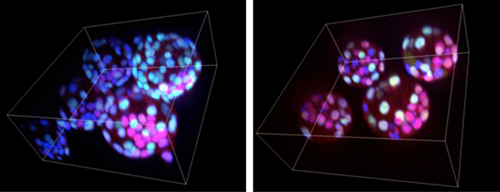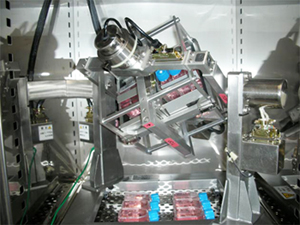| RIKEN Center for Developmental Biology (CDB) 2-2-3 Minatojima minamimachi, Chuo-ku, Kobe 650-0047, Japan |
August 30, 2009 – Were lengthy space flights to become a reality, the question of whether humans and other animals could reproduce normally when living in low gravity would need to be addressed. Previous studies have focused on species of fish, amphibians and birds, but little work has been done to date on mammalian reproduction in microgravity due to the limitations imposed by technology and the stress responses in rats and mice.
Sayaka Wakayama and colleagues in the Laboratory for Genomic Reprogramming (Teruhiko Wakayama; Team Leader) have now studied reproduction and early development in mice in simulated microgravity conditions. In an article published in PLoS One, they report that while fertilization is possible in low gravity, subsequent development is perturbed. To achieve the most realistic simulation of microgravity, the team used a newly developed device known as a three-dimensional clinostat, which uses rotation on two axes to evenly distribute gravitational pull in all directions (rather than the unidirectional downward pull we normally experience). Previous studies on mammalian development had been performed using a one-dimensional clinostat, but the results were equivocal. Wakayama first tested whether in vitro fertilization would be possible in microgravity, and found that the success rate for fertilization was no different from that at 1G, which suggests that mouse gametes are unaffected by low gravity.
As a next step, they allowed zygotes created by IVF continue to develop in the clinostat before implanting them into recipient females. But although the embryos could develop to the 2-cell and even the blastocyst stage, they did much less well when transferred into a surrogate mother – the rate of generation of offspring from the microgravity embryos was little more than half that when using embryos derived in normal gravity. Fertility of the mice born from microgravity embryos, however, was normal, as shown by their ability to mate and have offspring of their own. To determine the reason behind the developmental problems, Wakayama took a closer look at the microgravity embryos’ cell differentiation and polarization. In the early embryo, there is normally a clear demarcation between regions expressing Cdx2 (which contribute to the extraembryonic trophectoderm) and those expressing Oct4 (which give rise to the embryo proper). But in the microgravity embryos, an unusual number of cells expressed both. Surprisingly, the blastocysts remained polarized, with the inner cell mass located in the expected position. These results have important implications for the prospects of reproduction in space, but remain preliminary in their scope. “What we have shown using this new technology will still need to be replication in actual microgravity conditions,” cautions Wakayama. “So we are looking forward to being able to perform those experiments once the Japanese experiment module “Kibo” in the International Space Station is complete.” |
|||||||
|
|||||||
 |
| Copyright (C) CENTER FOR DEVELOPMENTAL BIOLOGY All rights reserved. |

